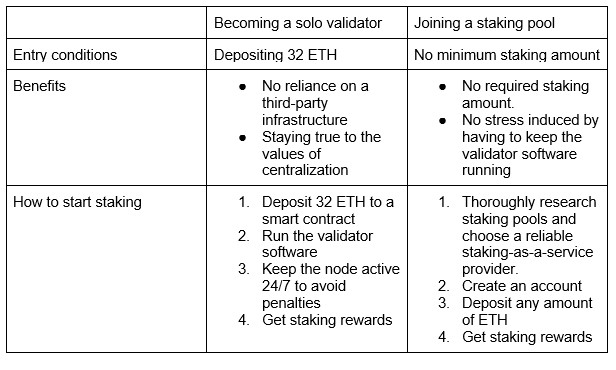Ethereum 2.0 is big news in crypto. Still, the update is so complex that, unless you are a human AI like Buterin, it can be hard to get the hang of it.
This post is a 5-minute walkthrough of the key phases of ETH2, ways in which you can contribute to the network, validator rewards, and penalties.
The History of Ethereum 2.0 and When It Was Released
Before we get deeper into the specs of the update, let’s circle back to its origins and explore the rationale behind ETH2.
In 2013, Buterin derived the idea for Ethereum from Bitcoin. Back then, blockchain-based technology was still a novelty, so sticking to tried-and-true PoW was sensible.
However, Buterin and Gavin Wood understood the key limitation of the Bitcoin network - a narrow focus. The blockchain is predominantly used for financial transactions - the Ethereum team believed the technology has a broader field of application. They built a customizable platform that allowed developers to deploy decentralized apps for use cases that transcend cryptocurrency - legal agreements, DeFi, NFTs, and others.
As the number of dApps grew, the network hit roadblocks.
- Low transaction throughput doesn’t allow Ethereum to catch up to traditional financial institutions - where Visa processes 1700 transactions per second, Ethereum can pull off 15 at best.
- High energy consumption driven by Proof of Work hinders Ethereum’s large-scale adoption.
- High entry barrier - to start mining ETH, you need to invest in ASICS and be fairly tech-savvy. These conditions make the network inaccessible to the general population.
- Security challenges - there’s a strong centralization trend (meaning that the mining power is centered around several entities) in crypto mining, increasing the odds of a 51% attack.

To solve these issues, the Ethereum team ideated the ETH2 update. At the moment, Phase 0 - the PoS-based Beacon Chain is live. Here’s what the future holds:
- Phase 1: the introduction of sharding (scheduled for release in 2022)
- Phase 1.5: the mainnet merges with the PoS network as a shard (also likely to come out in 2022).
- Phase 2: Enabling smart contracts on shards (estimated release date - 2023).
How to Become a Validator?
To join Ethereum staking and get annual rewards, you need to either become a solo validator or join a staking pool on Redot.
Here’s how they are different and how to get started:

Attestations
Simply put, attestations are votes that validators propose to the Ethereum network during each epoch (a 6.4 minute period).

To understand how Ethereum validators vote on blocks, let’s break the process into 5 steps.
- Generation: each validator creates a validation based on blockchain data available at the time.
- Propagation: the vote is transmitted across the Ethereum network.
- Aggregation is a way of putting the votes of the committee under the common denominator and merging them together to avoid excessive data growth.
- Propagation: a new, aggregated attestation is distributed across the network and shared with validators.
- Inclusion: an aggregated attestation is added to the block.
Staking Rewards and Penalties
Ethereum Staking Rewards
Ethereum validators are incentivized to stake Ethereum and verify blocks by network rewards.
These come in two types:
- Attestation rewards. Validators are rewarded for attestations when a) the head, source, and target of a block are correct, b) the inclusion delay metric is positive.
- Base rewards are the equivalent of block rewards in PoW blockchains. Two factors influence the reward size: how much ETH is staked (based rewards are inversely proportional to the amount of deposited tokens) and a base rewards factor.
Penalties for Ethereum Validators
To ensure accountability and order across the network, the development team introduced punishments for validator inactivity or malicious behavior.
Here’s a short guide to all control mechanisms the Beacon Chain employes:
- Inactivity penalties hit all validators on the network if it doesn’t reach finality in 4 epochs.
- Penalties (the reduction of effective balance) due to a miscasted vote.
- Quadratic leak for validator unavailability.
- Slashing - the forceful network exit.
To track validators who are penalized or slashed, you can use ETH2 block explorers.
How MEV impacts Eth 2.0
MEV (short for Miner Extractable Value) is a way to describe miners’ attempts to increase their profits by reordering block records and increasing transaction fees.
Why Is MEV a Harmful Trend?
Since MEV increases transaction costs, it negatively impacts end-users.
Inflated gas fees and arbitrage drive users away from decentralized apps and encourage developers to deploy their platforms on proprietary blockchains.
How MEV Impacts ETH 2.0?
First things first, the network update does not address the MEV problem. In fact, MEV income for ETH2 validators could amount to 1.73 ETH, 70% more than they make now.
While inconvenient for end-users, MEV is not all bad news.
For validators, it's an extra incentive to join the network. Encouraged by MEV, more people will stake ETH, contributing to the platform’s decentralization and security.
For end-users, on the other hand, miner extracted value means having to pay more for transactions. On the global scale, the numbers are huge in MEV income - over $1.4 billion are extracted from DeFi application users per year.
For now, the development team made no statement on addressing the MEV challenge - hopefully, Buterin and Co will come up with restraining mechanisms in the future.







